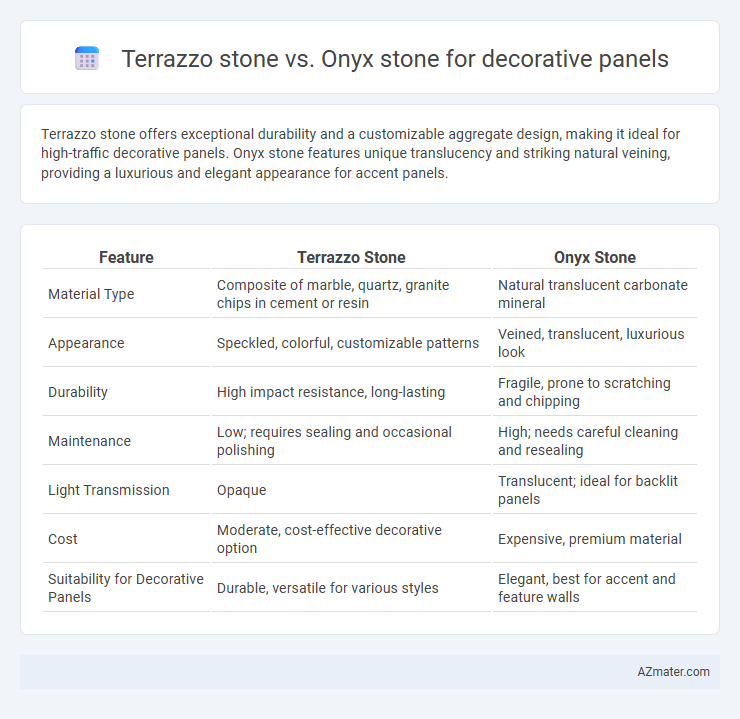Terrazzo stone offers exceptional durability and a customizable aggregate design, making it ideal for high-traffic decorative panels. Onyx stone features unique translucency and striking natural veining, providing a luxurious and elegant appearance for accent panels.
Table of Comparison
| Feature | Terrazzo Stone | Onyx Stone |
|---|---|---|
| Material Type | Composite of marble, quartz, granite chips in cement or resin | Natural translucent carbonate mineral |
| Appearance | Speckled, colorful, customizable patterns | Veined, translucent, luxurious look |
| Durability | High impact resistance, long-lasting | Fragile, prone to scratching and chipping |
| Maintenance | Low; requires sealing and occasional polishing | High; needs careful cleaning and resealing |
| Light Transmission | Opaque | Translucent; ideal for backlit panels |
| Cost | Moderate, cost-effective decorative option | Expensive, premium material |
| Suitability for Decorative Panels | Durable, versatile for various styles | Elegant, best for accent and feature walls |
Introduction to Terrazzo and Onyx Stones
Terrazzo stone is a composite material made from chips of marble, quartz, granite, or glass set in cement or resin, prized for its durability and customizable patterns in decorative panels. Onyx stone, a natural, banded form of calcite, is valued for its translucent beauty and striking color variations, making it ideal for backlit decorative panels. Both materials offer distinct aesthetic and functional qualities, with terrazzo providing robustness and endless design options, while onyx delivers elegance and a unique glow.
Composition and Material Differences
Terrazzo stone consists of a composite material made from chips of marble, quartz, granite, or glass embedded in a cement or epoxy resin binder, offering durability and a speckled appearance ideal for decorative panels. Onyx stone is a natural, translucent form of calcite with distinctive banding and vibrant colors, prized for its unique veining but more fragile and sensitive to acids compared to terrazzo. The primary material difference lies in terrazzo's engineered mixture providing strength and versatility, whereas onyx's natural crystalline structure offers aesthetic appeal with delicate handling requirements.
Visual Aesthetics and Color Options
Terrazzo stone offers a vibrant, speckled surface with a wide range of customizable color chips, providing dynamic and playful visual aesthetics ideal for modern and eclectic decorative panels. Onyx stone, prized for its translucent properties and natural vein patterns, creates luxurious and dramatic panels with rich, depth-enhancing hues that glow under backlighting. While terrazzo excels in bold color variety and texture, onyx delivers elegance and sophistication through its unique, natural color gradients and striking light diffusion.
Durability and Lifespan
Terrazzo stone offers exceptional durability with high resistance to scratches, stains, and impact, making it ideal for long-lasting decorative panels in high-traffic areas. Onyx stone, while visually striking and translucent for backlit designs, is softer and more prone to scratches and etching, resulting in a shorter lifespan compared to terrazzo. The lifespan of terrazzo decorative panels can exceed 50 years with minimal maintenance, whereas onyx panels may require more frequent care to preserve their appearance over time.
Maintenance Requirements
Terrazzo stone requires low maintenance with periodic sealing and routine cleaning to prevent surface stains and maintain its polished look. Onyx stone demands more careful upkeep, including gentle cleaning with non-acidic products and frequent sealing to protect its translucent surface from scratches and etching. Both materials benefit from prompt spill management, but onyx is notably more sensitive to humidity and harsh chemicals than terrazzo.
Cost Comparison
Terrazzo stone generally offers a more budget-friendly option for decorative panels due to its composite materials, which include marble chips and cement or resin, resulting in lower production costs compared to onyx. Onyx stone, known for its translucent qualities and unique veining, commands higher prices driven by rarity and labor-intensive extraction and fabrication processes. When considering cost-effectiveness for decorative panels, terrazzo provides a durable, versatile alternative, while onyx serves as a premium choice with distinct aesthetic value.
Suitability for Decorative Panels
Terrazzo stone offers excellent suitability for decorative panels due to its high durability, customizable aggregate patterns, and resistance to stains and scratches, making it ideal for high-traffic and modern design applications. Onyx stone provides a unique aesthetic with its translucent, layered appearance and vibrant color variations, perfect for accent panels and backlit installations requiring a luxurious, eye-catching effect. While terrazzo excels in longevity and versatility, onyx demands more maintenance and careful handling, positioning it best for sophisticated, low-impact decorative panel usage.
Environmental Impact and Sustainability
Terrazzo stone, composed of recycled glass, marble chips, and cement, offers a sustainable choice with a lower carbon footprint due to its use of industrial byproducts and long-lasting durability. Onyx stone, a natural mineral formed over thousands of years, requires extensive quarrying and energy-intensive processing, resulting in higher environmental impact and less eco-friendliness compared to terrazzo. Terrazzo's recyclability and reduced resource extraction make it a more environmentally responsible option for decorative panels, supporting green building certifications and sustainable interior design.
Installation Process and Flexibility
Terrazzo stone offers a streamlined installation process due to its pre-cast slabs, allowing quick fitting on decorative panels with minimal adjustment. Onyx stone demands meticulous handling and a skilled installer because of its translucency and natural veining, requiring careful alignment and backing for support. Terrazzo's versatility supports various shapes and sizes, while Onyx's fragility limits flexibility, making it best suited for smaller, controlled applications.
Best Applications and Design Ideas
Terrazzo stone offers exceptional durability and versatility, making it ideal for high-traffic decorative panels in commercial spaces like lobbies and restaurants, where its customizable color chips create vibrant, artistic designs. Onyx stone, prized for its translucency and luxurious veining, is best suited for backlit decorative panels in upscale interiors such as hotels and residential feature walls, adding elegance and a dramatic light effect. Combining terrazzo's resilience with onyx's aesthetic appeal enables unique design contrasts, perfect for modern, sophisticated environments seeking both functionality and visual impact.

Infographic: Terrazzo stone vs Onyx stone for Decorative Panel
 azmater.com
azmater.com